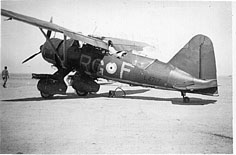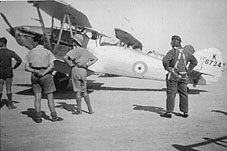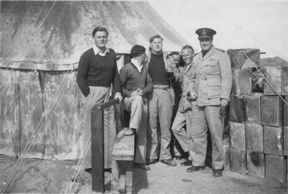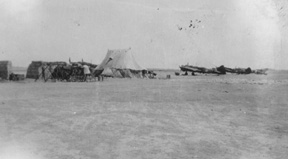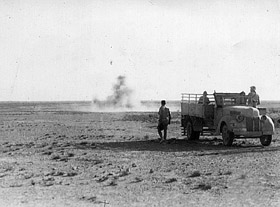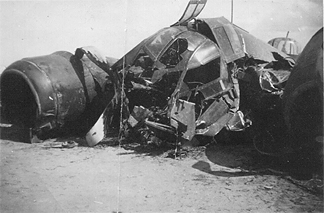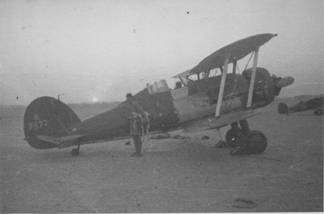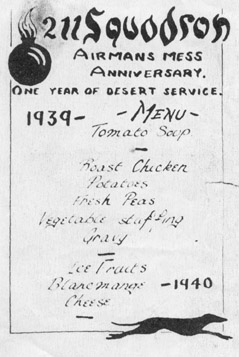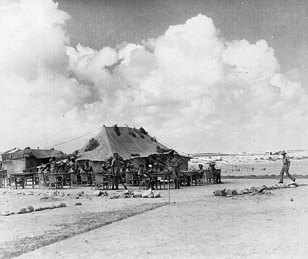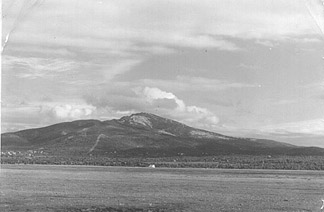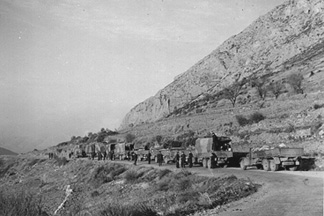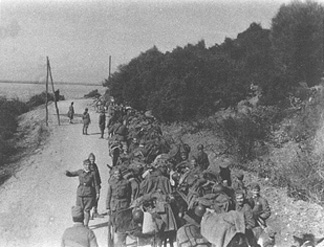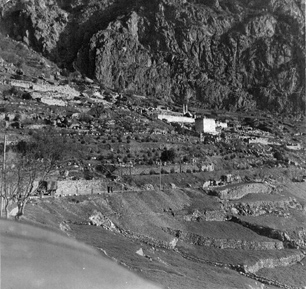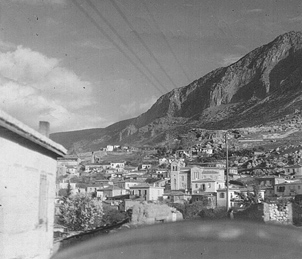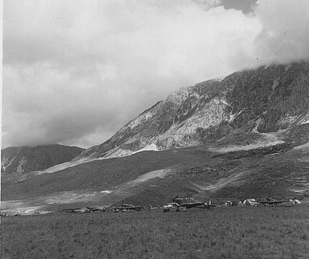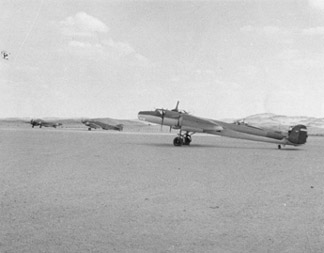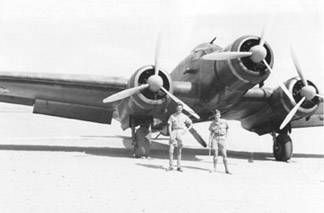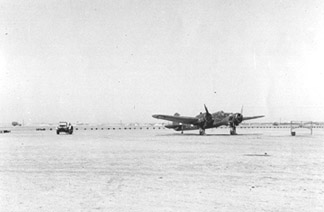 |
 |
|||||||||||||||||||
|
Ernest Leonard Cooper 649413 RAFVR Len Cooper joined the RAF in June 1939 and trained as an engine fitter. He was 18 when he joined 211 Squadron at El Daba. He was one of the 211 Squadron old hands sent East in early 1942 aboard HMT Yoma. At the end in Java, he arrived at Tjilatjap in the middle of a Japanese bombing raid. A PoW of the Japanese, Len survived captivity in Java, Singapore and at Honshu in Japan. A great many of his pictures bear the stamps of the Imperial Japanese Army, and most of those cryptically carry a pencilled identification “Davis Ward 8 23797”. Two of the 211 Squadron men who fell captive with Len were named Davis: 1317077 Christopher Davis, who died at Labuan and is commemorated on the Kranji memorial, and 1087242 George William Davis, who survived Haruku and Ambon. Given the comradeship of men in such adversity, it is unsurprising that Len apparently came to look after another man’s mementoes. Len kindly offered the use of his collection, which like others includes his own and others’ pictures. A fine collection, which is quite large and diverse: an attempt at presentation in chronological order seems sensible. Many of Len’s photographs were annotated, though sometimes in more recent years. Subsequently, Len also wrote of his experiences from 1941 to 1942, and his narrative follows the photograph section. Returning home after the war, Len later migrated to Canada, and towards the end of his life was living not far from the family of KCVD Dundas DFC. Len’s photograph albums safely circumnavigated the world by post. In 2002 he, too, undertook a determined final lap to visit old friends, if at a more leisurely pace. Len died in July 2003.
Westland Lysander RG -F L4717. No 208 Squadron had Lysanders from January 1939 onwards. In the Velox print, the aircraft has that “new paint” look about it and the spat winglets are bombed up. A battered tin & hose lie in the shade of the fuselage. The Squadron had earlier used the code GA, but here RG is plainly already in use. The print has the processor’s roll no.stamped on the rear: 026. Compare this with the next photo.
Captioned “Hawker Hind” in one hand, and “113 Sqn” in a later hand. K6734 is indeed a Hawker Hind of 113 Squadron: they kept close company with 211, having spent time with them at Grantham and leaving for Egypt within a fortnight of each other, both later serving in Greece (and in the Far East, too, if far apart). In the background can be seen the wing of a Lysander. This photo too bears the processor stamp 026: that is, from the same roll of film. The sun angle is almost identical. 113 Squadron's conversion from Hinds to Blenheims is given variously as March 1939, June 1939 (a month later than 211 Squadron) and in the RAF Narrative even later, as September 1939. The 113 Squadron Operations Record Book records the arrival of the first Blenheim I on 1 June 1939, at Heliopolis, where they had just returned after a month out in the Desert at El Daba, where 211 Squadron had also taken station in March and April. Here the Hind is still in silver over-all: that is, before camouflage finish was needed. Conclusion: these aircraft were photographed together, on the same day probably sometime between March and May 1939, probably at El Daba. The aircraft bears no Squadron identification, as either ‘113’ or as the 2 letter code code. Squadron identification was in a state of flux about this time. Previously supplied information about the history of this aircraft has turned out to be incorrect. One of a batch of 224 aircraft delivered between November 1936 and August 1937 under Contract 424397/35, K6734 was first delivered to 139 Squadron on 21 April 1937. By August that year it was serving with 108 Squadron. Taken on charge by 113 Squadron on 15 March 1938, within a fortnight the aircraft had gone to the Packing Depot (24 March) for service with them in the move to the Middle East. By 30 April 1938 the Squadron itself was en route. By September 1939 the aircraft was at the Conversion Flight at Heliopolis. Having passed to 102 Maintenance Unit in June 1940, with just over 500 hours on the clock the aircraft went to the South African Air Force at some date after 1 April 1941, perhaps as a ground-instructional airframe, surviving until October 1944.
The date is certain, as is the identity of the blonde giant Cpl G “Mush” Hale 543599 in the roll-neck, centre— both confidently noted by Len Cooper. The figure on the right in tropical kit must be The Bish, who is also certainly present. His shoulder tab rank rings are just barely discernible and taken with the burly figure and demeanour, this is F/Lt JR Gordon-Finlayson, genial in the company of his young charges, themselves clearly ready for festivities: Mush holds a large tankard, already down to half-tide! Also notable is the sump-oil camouflage of the mess-tent, and the fuel-tin revetment beside the entry way.
The aircraft nearest the camera is UQ-J
Early morning and the booby-trap party is out cleaning up thermos bombs dropped overnight by the Italians. See also Abbs Letters from Len No. 3, and “Doc” Squire.
This and other photographs of the accident to L1486 was also held by other Squadroon members: Grierson, Hoyes, Sainsbury, Sharratt and Wingrove.
A more recent hand has written in biro “March '41”. An evocative shot of Gloster Gladiator K7977, looking rather worn, with another Gladiator dimly in the right background. The airfield is utterly flat to the horizon, sandy and devoid of grass. There is no vegetation as far as the eye can see. The sun is just above the horizon. There is somebody in the cockpit (perhaps the pilot as he seems to be helmeted, though the a/c is still tethered, the engine is “off”, and an engine cover of some sort is roughly over the prop boss). The airman in the foreground, in shorts and short sleeves, carries a pack of some sort which looks like a 'chute but with webbing everywhere. Other covers of some sort lie on the dirt beyond the aircraft. At some date the aircraft was to wear the Squadron codes RT-P, however, here there is no trace of markings other than the faint roundel of the more distant Gladiator. No. 112 (Fighter) Squadron certainly had K7977 on charge and the Squadron was present in the Western Desert (Sidi Haneish etc) and in Egypt (LG ‘Z’) in the period between June 1940 and 211’s departure for Greece that November. The Squadron also sent a detachment to The Sudan that July, soon reorganised as the autonomous ‘K’ Flight. By January 1941, 112 had also gone to join the British Air Forces in Greece and by mid February were a unit of Coote's Western Wing at Yannina and Paramythia. However, by then K7977 had already been lost, shot down by Fiat CR 42s over Metemma in Abyssinia on 6 November 1940 at the start of the Abyssinian campaign. Flying Officer Haywood of the ‘K’ flight detachment was patrolling in K7977 with a flight of 1 SAAF Squadron Gladiators, near Gallabat on the northern border with Sudan. The flight was bounced by CR42s while attacking a flight of Caproni 133s, Haywood crashing in flames. Here then, the aircraft is shown, codeless and in a somewhat worn state, possibly at some date between June and October 1940, in either Egypt or the Western Desert. K7977 is briefly mentioned on the 112 Squadron website being developed by Robert Brown (see the Gladiator section of Personnel page).
Sgt WOp/AG R Wingrove’s copy of this little memento was dated to the rear: 4 August 1940.
Dining al fresco, in cane chairs outside the mess tent. An almost identical shot can be seen in Jim Fryatt’s collection. A closely similar and firmly identified shot is among Geoff Grierson’s prints, enabling a more accurate summary here. At this period the camouflage is really rudimentary despite the Italian offensive, as can be seen in pictures in other sections from the period up to the departure to Greece. Far behind the figure on the right is a Blenheim at dispersal. Len and Jim Fryatt have a number of photographs in common in their collections, those for the convoy and camp at Paramythia notable among them.
A fine shot across the empty grass landing field at Menidi (Tatoi), 1940. Depending on conditions, aircraft landed and departed left to right. Just visible on the slopes of the left middle-ground, a group of houses . The white object in the middle distance is a 211 Squadron tent, and just behind it the motion-blurred image of a vehicle. The presence of this tent, which it surely is in the sharp and identical print also held in Jim Fryatt’s set, and again in my father’s own shot, gave rise to an interesting puzzle in a quite different but very familiar shot. Beyond the tent lies a line of telegraph poles, densely wired, bespeaking proximity to a main road or railway line. Both of these lay to the immediate East of the aerodrome area on maps of the 1930s, solving a further puzzle of direction and mountain identification. As we are looking East, presumably from somewhere on the hangar and apron side of the field, the mass of familiar rising ground can only be that of the Pentelikon (not Parnes, after all).
My father, Ron (Mick) Dudman, and Jim Fryatt all had shots of the convoy in their collections, some of them duplicates.
In this shot there are six aircraft. The tail of a Blenheim is just visible on the left edge, mid ground. To its right are the dark wings of a single Gladiator, then 4 Hurricanes. Beyond the Hurricanes is the main encampment.
With 2 of the Yugoslav S79s, at Helopolis soon after evacuation from Greece. Despite Len’s own caption, Fitter IIE RJ “Mick” Dudman recalled that HM Peter, King of the Yugoslavs, arrived at Paramythia in an S79, escorted by the Dornier. Mick’s photo set shows that he left Paramythia for Menidi in that S79 (and escorted by a 211 aircraft, both as recounted by my father). The aircraft shown here is noted by Ciglic and Savic as Do 17 3363 of 209 Escadrila. Short Sunderland in World War II shows Peter aboard a lighter, apparently about to board a 230 Squadron Sunderland (and as reported by Shores & Cull etc), while the BAFG ORB also seems to imply that is how he left Greece The 230 Squadron record confirms his evacuation to Crete by Sunderland on 18 April but with no further flight for him after that. Alison Legge, widow of the late F/Lt Farrington, recalled with great confidence that Farrington escorted the young King to Egypt. A complex narrative: like many another evacuee from Greece it seems that Peter went to Crete by Sunderland. Apparently from there, he once more boarded a Yugoslav aircraft to Egypt, again escorted by 211 Squadron. Whether he came to Egypt in an S79 or the Do 17, it’s a minor epic. “Colour of the day “ would have been needed in spades, one would think.
The national roundel just visible far left.
A wonderfully evocative shot from the Middle East. This aircraft, originally of 14 Squadron, was with 211 Squadron in February 1942 in Java. There are many fine photos here. Narrative of EL Cooper 1941—1942 I was on leave in Cairo over the Christmas [of] 1941. I left Wadi Gazouza mid-December, and was given five days travelling time. Spent a very enjoyable Christmas and New Year in Cairo, it was the first leave I had since leaving the UK, February 1940. A few days before my leave ended, I received a message to report to RAF Helwan at the end of my leave. Not until I got to Helwan that I discovered 211 had been re-formed and we were equipped with Blenheim Mark IVs, going to the Far East. The groundcrew personnel had travelled from Wadi Gazouza over Christmas, spent Christmas Day on a river boat on the Nile. Most of the aircraft had left Helwan by the time I arrived. Within a couple of days we sailed in the Yoma from Tewfik for Singapore. Two days after leaving Colombo we got the report that Singapore had been taken by the Japs. For the next week or more we travelled thousands of miles around the Indian Ocean. [Len Abbs also gave an account of this voyage. HMT Yoma was part of convoy JS1, the first part of Operation Stepsister moving Middle East AIF and other troops to the Far East. While Abbie and others recall that HMT Yoma berthed at Oosthaven in Java on Friday 13 February 1942, in fact records of the time are clear that she arrived on 14 February. In Malaya, all RAF units had withdrawn to Kluang or Singapore by 16 January, and all the bomber Squadrons to Sumatra by the last week of January. The island surrendered on 15 February 1942. The four 211 Squadron Air Party flights were heading for Sumatra from the outset. From published Stepsister accounts, it is clear that Sumatra had already been made their destination before departure from Colombo on 3 February 1942. It may be the announcement of this on board that Len was recalling.] I was on the foredeck about 5am looking out to sea. Mr Weir the ship’s engineer came up to me and said “Laddie, see those small islands out there, they are what remains of the island of Krakatoa the greatest volcano ever known, erupted 1880-something killing half a million people.” “Shit!” I said, “we must be near Java”. I learnt all about Krakatoa at school. “Aye, laddie” said Mr McWeir, “we are”. He had a strong Scottish accent. We sailed on through the narrow waterways and went into a little port. When the gangplank was lowered, I went ashore with a few other guys. We met some soldiers in a uniform we didn’t recognise. I asked “Where are we?”. He said “you don’t know where you are?” in very good English. “This is Oosthaven, Sumatra”. We couldn’t get anyone on the ship to tell us where we were going! We boarded a train later that day. Must mention, 84 Squadron staff were with us. Headed inland, we were then told we were going to occupy and airfield P1 [sic, P2] near Palembang. We travelled until nearly dark, the train stopped, we were told the airfield had been captured by Jap airborne troops. We were put on small-gauge railway trucks and taken to a rubber plantation, had a meal and stayed the night. Next day we were taken back to the train we had been on from Oosthaven. We travelled back to Oosthaven, got back on the Yoma, and sailed for Tanjong Priok, Batavia, Java. We were billetted in Dutch Army barracks in Batavia. They didn’t know what to do with us. The RAF didn’t care! [In the logistical nightmare that followed the rapid Japanese advance in Malaya, some 10,000 RAF personnel arrived in Java between 12 and 18 February 1942.] I was on a working party unloading ships at the docks. one day we had a big scare, Jap bombers came over in great numbers. We got away from the docks as fast as we could. I just sat in a trench and watched the war go by. No bombs were dropped near us. Jap fighters did a lot of strafing. In a lull I stood on the dock and saw the Yoma sail out. I said “I’m glad I’m not on that bloody old thing!” Ye gods! I should eat those words, for what happened to me later. From Batavia we travelled by train to Chilajap [Tjilatjap, Cilacap] on the south coast. It was, or is, the only port on the south coast of Java, owing to the prevailing winds off the Indian Ocean. The breakers are about 30 feet high all the year round. The port is in a bay, beyond an island, narrow inlets each end. I would think the biggest ship that could get in is about 10,000 tons. After arriving in Chilajap, the officer in charge told us to go to the Dutch barracks, arrangements had been made to give us breakfast. We strolled back to the station. The officer in charge said we should get away from the station, there might be an air raid. Not long after he said this, the air raid siren sounded. Within minutes bombs were being dropped. I with two other guys ran into a coconut grove. We found a round hole about six feet deep and two feet across which we quickly got into. Bombs were being dropped on the station, the shrapnel was knocking the tops off the coconut trees, coconuts were dropping everywhere. I’ve learnt lately from a book written by two Jap naval officers, called The Battle of Midway they mentioned 182 aircraft from carriers off the North coast of Java bombed Chilajap. After Chilajap we got on a train. During the night heading inland, I was on the second train. The first train was ambushed, many guys were killed. It was just after dawn we arrived at Tasicmalaya station. The Dutch troops, mostly Javanese, were running around with white flags, head- or arm-bands. The Dutch had capitulated. There were about 250 of us moved into a school near the station. The Japs moved into the town a couple of days later. We were moved onto the airfield at Tasicmalaya. Then started three and a half years of captivity. Garoot, Bandoeng, Batavia, Singapore, Wakayama, Osaka, and Ikuno (Japan). Home via Yokohama, Manila, Pearl Harbour, Vancouver, Halifax, Queen Elizabeth to Southampton. What a hell of a way to spend one’s youth! Sources Legge A correspondence with author Ciglic & Savic Dornier Do 17: The Yugoslav Story (Jeroplan Books 2007)
www.211squadron.org © D Clark & others 1998—2025 |
|||||||||||||||||||
